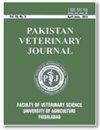蓖麻素减轻顺铂致大鼠睾丸和精子损伤
IF 5.4
3区 农林科学
Q1 VETERINARY SCIENCES
引用次数: 17
摘要
接收:修订:接收:在线发布:2019年9月11日2019年9月19日2019年12月02日2019年12月31日癌症是动物死亡的主要原因之一。顺铂(CP)是一种化疗药物,用于治疗几种类型的实体瘤。然而,它会对多个器官产生许多副作用,特别是睾丸组织。本研究阐明了蓖麻素(CAS)对CP致大鼠睾丸损伤的缓解作用。选取24只成年雄性斯普拉格·道利大鼠,分为四组。每组由6只动物组成。各组处理如下:对照组(0.9%生理盐水),CP处理组(10 mg/kg)。b.wt.), CP+CAS处理组(10 mg/kg)。b.wt。CP和50 mg/kg。b.wt。CAS)和CAS处理组(50 mg/kg)。b.wt)。治疗时间为1周。评估了生物化学、组织形态学、激素和生精特征。结果表明,CP处理显著降低了过氧化氢酶(CAT)、超氧化物歧化酶(SOD)、过氧化物酶(POD)和谷胱甘肽还原酶(GSR)活性,提高了硫代巴比妥酸活性物质(TBARS)水平。生殖细胞和间质细胞数量、精小管上皮高度和直径、血浆和睾丸内睾酮浓度、日精子产生量(DSP)及其效率均降低。而管腔直径和间隙增大。CAS是一种类黄酮,具有抗氧化和清除活性氧(ROS)的特性。因此,它通过减轻CP对睾丸组织的毒性,在一定程度上恢复了这些损伤。©2019 PVJ。版权所有本文章由计算机程序翻译,如有差异,请以英文原文为准。
Casticin Alleviates Testicular and Spermatological Damage Induced by Cisplatin in Rats
Received: Revised: Accepted: Published online: September 11, 2019 September 19, 2019 December 02, 2019 December 31, 2019 Cancer is one of the leading causes of mortality in animals. Cisplatin (CP) is a chemotherapeutic drug, which is used in treatment of several types of solid tumors. However, it causes numerous side effects on multiple organs, specifically to testicular tissues. This study elucidated the alleviative effects of casticin (CAS) on CP induced damages in testes of rats. Twenty-four adult male Sprague Dawley rats were used and divided into four groups. Each group consisted of six animals. These four groups were treated as followed: Control group (0.9% saline), CP treated group (10 mg/kg. b.wt.), CP+CAS treated group (10 mg/kg. b.wt. CP and 50 mg/kg. b.wt. CAS) and CAS treated group (50 mg/kg. b.wt.). The treatment duration was one week. Biochemical, histomorphometric, hormonal and spermatogenic profiles were assessed. Results of present investigation indicated that CP treatment significantly decreased the activities of catalase (CAT), superoxide dismutase (SOD), peroxidase (POD) and glutathione reductase (GSR), while thiobarbituric acid reactive substances (TBARS) level was increased. Furthermore, the count of germ cells and Leydig cells, epithelial height and diameter of seminiferous tubules, plasma and intratesticular testosterone concentrations as well as daily sperm production (DSP) along with its efficiency were decreased. Whereas, luminal diameter and interstitial spaces were increased. CAS is a flavonoid, which exhibits antioxidant and reactive oxygen species (ROS) scavenging properties. Therefore, it restored these damages to some degree by attenuating CP induced toxicity in testicular tissues. ©2019 PVJ. All rights reserved
求助全文
通过发布文献求助,成功后即可免费获取论文全文。
去求助
来源期刊

Pakistan Veterinary Journal
兽医-兽医学
CiteScore
4.20
自引率
13.00%
发文量
0
审稿时长
4-8 weeks
期刊介绍:
The Pakistan Veterinary Journal (Pak Vet J), a quarterly publication, is being published regularly since 1981 by the Faculty of Veterinary Science, University of Agriculture, Faisalabad, Pakistan. It publishes original research manuscripts and review articles on health and diseases of animals including its various aspects like pathology, microbiology, pharmacology, parasitology and its treatment. The “Pak Vet J” (www.pvj.com.pk) is included in Science Citation Index Expended and has got 1.217 impact factor in JCR 2017. Among Veterinary Science Journals of the world (136), “Pak Vet J” has been i) ranked at 75th position and ii) placed Q2 in Quartile in Category. The journal is read, abstracted and indexed internationally.
 求助内容:
求助内容: 应助结果提醒方式:
应助结果提醒方式:


